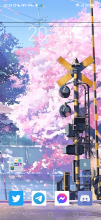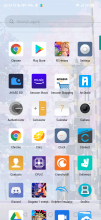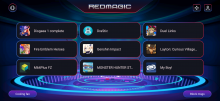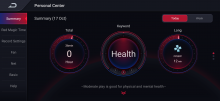Hands on with my first gaming phone - a week with the Red Magic 5S
Just a few years ago, I laughed at the idea of a gaming phone. I still remember when the first Razer Phone was announced, and all I could wonder is who it was aimed at. Who would spend so much money on a device focused on a need that just didn’t seem to exist. Roll on 2020 and here I am, garish phone in hand; did the market change, or did I?
Red Magic's boxes always find a way to stand out.
The Red Magic 5S is Nubia’s latest gaming phone, acting as a somewhat incremental update from their early 2020 Red Magic 5G. Featuring a 144hz screen, shoulder triggers, an internal fan for cooling, and a lavishly over the top design, it’s a brilliantly unique phone in a sea of monotone bricks. Unfortunately missing out on the Snapdragon 865+, Nubia opted to use the basic 865 as the backbone of the device. It’s a bit of a shame to see the latest model not sport the latest processor; my best guess as to why this is would be as a way of keeping costs down, but this is just speculation. In reality, the 865 is enough to deliver incredible performance on everything I want to use the phone for.
Before diving into gaming, it’s worth taking a look at the phone as a whole. It’s stunning. Opting for the more expensive “Pulse” model, the 5S comes packed with 12 GB of LPDDR5 RAM, and 256 GB of UFS 3.1 storage. The more muted silver model by comparison has 8 GB of RAM, and 128 GB of storage. Both designs look lavish, so it’s a shame to see the better specs locked to the red and blue design. While I am incredibly fond of it myself, I understand it’d be a bit much for some to use as their daily driver, and with both models lacking expandable storage options, you might find that 128 GB of internal storage filling quickly.
The red and blue Pulse design is striking.
Booting the phone for the first time is a fairly standard Android experience. Nubia opting to stick with a very vanilla feel, there’s no over the top skin forced on you–at least not in daily use. Looking to the left side of the phone, you’ll find a red hardware switch. Where some phones make use of these switches to toggle mute or auto-rotate settings, this one is locked into opening the phone’s hot gaming mode. Going into this gives you easy access to many of the phone’s unique features. There’s a few quality of life things like blocking calls and messages while playing games, which might be particularly handy for people who enjoy recording their gameplay. On top of this, you can enable or disable the phone’s fancy internal fan, switch between 60, 90, and 144hz for the refresh rate, enable “4D shock” in certain games, and even map areas of the screen to the touch shoulder buttons on the phone. The phone also treats you to some live information on your CPU, GPU, and network speeds. There’s a lot to like here, but it’s not without fault. You’ll find the menus littered with odd translations, minor spelling mistakes, and a few outright quirks. It’s nothing that will really ruin the phone for you, but it does take away from the otherwise premium feel of the device.
One of the nice features on offer is the ability to record and play macros. On other phones, I’ve had to rely on apps like FRep, and while they work fine, it’s great to have this functionality as standard. It’s as simple as hitting record and doing what I want saved. For things like Hero Merit farming in Fire Emblem Heroes, it’s a blessing. Another thing to note is that all settings are stored on a per-app basis, so if you configure your shoulder buttons in a certain way for one game, you won’t be faffing about to get them how you like them every time you switch to something else.
The Pro Handle really does make it into a mini Switch.
Should you decide to invest in the accessories, there's also a few neat options on offer, the most significant of these coming in the form of the Pro Handle. Put simply, the Pro Handle is a special case for the phone that has a rail on each side, allowing you to mount Nubia’s take on a Joy-Con to each side. With two controllers, you have access to an incredible gaming experience, albeit not quite as convenient as Sony’s Xperia Play design–but really what has ever been as good as that design? When in the gaming mode, you can configure these controllers the same way as the shoulder buttons, mapping them to areas of the screen. For games like Genshin Impact, I’ve found myself just using the left controller for its analogue movement, and using my right hand for camera panning and hitting attack buttons. With these configurations saving from game to game, you can really go to town with how you set them up. For better or worse, however, you can only use these controllers like this while in gaming mode; they must be mapped to an area of the screen. When not in gaming mode, however, they function as standard Bluetooth controllers, though again with some limitations. In fairness, the limitation is less a design fault of Nubia’s, and more the apps you might be using them with: they are two individual controllers. With many emulators, they just won’t work right. Some emulators will only let you configure one controller, and others will detect them both as the same controller, essentially giving you access to half of the available buttons. While some apps like Dolphin do work properly with both controllers together, I’m fairly sure this is an exception more than it is the norm.
For emulation, you have to get a little crafty. What I ended up doing was bunching all the on-screen buttons into one corner, and configuring the controllers to hit them. After that, I set the button transparency to 0%, and voila! You have a somewhat awkward workaround! This setup has been my saviour for apps like Mupen64, Drastic, and PPSSPP, allowing me to use a comfortable and convenient controller where I was worried it simply wouldn’t be possible. It’s a good job too, because this phone is capable of playing pretty much everything I’ve thrown at it.
Other reviews I’ve seen online seem to focus on its performance with Fortnite, PlayerUnknown’s Battlegrounds, and Call of Duty Mobile, and while it performs admirably with each of these, they aren’t exactly where my interests lie. I bought this phone for two reasons: to play Genshin Impact on the go, and to achieve a long-standing dream of playing New Super Mario Bros. Wii from a mobile device. It does both of these things and more.
The hot kid on the block, Genshin Impact runs flawlessly on its highest settings. It looks incredible, and paired with the Pro Handle, it feels incredible too. With mobile gaming, my biggest issue has always been using touch-based analogue sticks. With no physical boundaries to feel, I’m constantly overextending and pulling my thumbs into uncomfortable positions. Being able to use a physical analogue stick really is a blessing, and the shoulder button on the right of the device has proved itself handy too. A somewhat simple setup, I have it mapped to somewhere near the middle of the screen, where prompts appear. What this means is that I can just keep hitting that to open chests, pickup items, and engage in simple dialogue. The only real disappointment is that the game is only capable of going to 60 FPS, leaving the phone’s 144hz display underutilised.
Looking to emulation, it’s handled everything I’ve thrown at it admirably. DS games I play with filters and high resolution 3D rendering, N64 games I play with the highest available resolution, and on PPSSPP I’ve found no issues playing Monster Hunter: Freedom Unite with 4x rendering resolution and 16x anisotropic filtering. It’s all flawless on this pocket prince. But what of Dolphin? What of my dreams to play one of the best Mario games on the go? I can say they are dreams no longer. I get a comfortable 60 FPS playing it and I couldn’t be happier. The vast majority of the games I’ve tried perform similarly also; from Wind Waker to Xenoblade Chronicles, the device doesn’t struggle at all, even running perfectly at 3x internal resolution for some GameCube games. It’s my go-to device to enjoy a Wind Waker randomiser. The only game I tried that the device struggled on was, quite surprisingly, Fortune Street, a party board game from Square Enix. It baffles me how it can run so poorly when the likes of Xenoblade have no issues, but I have no doubt there’s some unusual quirk to explain it somewhere.
Having used the phone for just over a week now, I really couldn’t be happier. It’s a marvellous device capable of more than I could have ever anticipated, and if we see more games like Genshin Impact gracing the mobile shores, it’s a device I’ll only be having more fun with down the line. I’m currently in the process of writing a more formal review, complete with video showcases of emulation quality and native app performance. Is there anything you want me to try, or any questions you want answering? Be sure to leave a reply, and I’ll try my best to tailor the review to what people want to know.

















